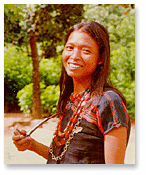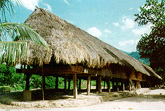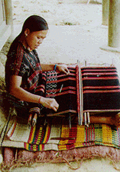TA-OI ETHNIC GROUP
|
|||

|
Name of
Ethnic Group: Ta Oi (Toi Oi, Pa
Co, Ba Hy, and Ba Ghy).
Population: Over 26,000 people. Locality: A Luoi District of Thua Thien-Hue Province and Huong Hoa District of Quang Tri Province. Customs and Habits: The communal house of the Ta Oi is called the Rong. It is built at the centre of the village and is a fairly elongated house. The children take the family name of the father and only sons have the right to inherit the family estate. The head of a lineage plays an important role in village affairs. Young Ta Oi men and women are free to choose their partners. They believe in animism and organize many ceremonies for Giang. Several years after the burial of a deceased person, the dead's lineage organizes a ceremony to exhume the dead's remains and build a funeral house with sophisticated decoration and statues around the fence of the funeral house. Culture: The Ta Oi language belongs to the Mon-Khmer Group and is close to the Bru-Van Kieu and Co Tu languages. The Ta Oi have managed to preserve many of their proverbs, folk songs, puzzles, and stories. Popular folk songs include Ka-loi, Ba-boih, Ro-in, and especially the romantic Cha Chap song. Gongs, string zithers, flutes, trumpets, drums, and pan-pipes are popular musical instruments of the Ta Oi. Costumes: Women wear shirts and skirts, but the skirt is usually knotted up to cover their chests. Men wear loincloths and short vests, or leave their upper torsos naked. Ornaments made from copper, silver, glass beads, and ivory are also popular. Economy: The Ta Oi practice a slash-and-burn method of cultivation and grow wet rice through this process. They are also good at horticulture and fish rearing in artificial ponds. |
||
|
|
|||
![]()




